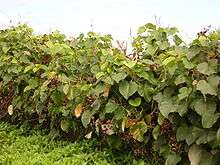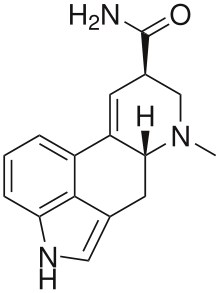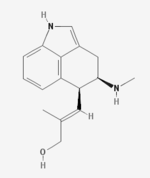Argyreia nervosa
| Argyreia nervosa | |
|---|---|
 | |
| Argyreia nervosa flowers (enlarge) | |
| Scientific classification | |
| Kingdom: | Plantae |
| (unranked): | Angiosperms |
| (unranked): | Eudicots |
| (unranked): | Asterids |
| Order: | Solanales |
| Family: | Convolvulaceae |
| Genus: | Argyreia |
| Species: | A. nervosa |
| Binomial name | |
| Argyreia nervosa (Burm.f.) Bojer | |
| Synonyms | |
|
Argyreia speciosa (L.f.) Sweet | |
Argyreia nervosa is a perennial climbing vine native to the Indian subcontinent and introduced to numerous areas worldwide, including Hawaii, Africa, and the Caribbean. Though it can be invasive, it is often prized for its aesthetic value. Common names include Hawaiian baby woodrose, adhoguda अधोगुडा or vidhara विधारा (Sanskrit), elephant creeper and woolly morning glory. The two botanical varieties are A. n. var. nervosa described here, and A. n. var. speciosa, a species used in Ayurvedic medicine, but with little to no psychoactive value.
A. nervosa seeds contain various ergoline alkaloids such as ergine.[2] A study reported stereoisomers of ergine to be found in the seeds at a concentration of 0.325% of dry weight.[3]
History
A. nervosa is a rare example of a plant whose putative hallucinogenic properties were not recognized until recent times. While several of its cousins in the Convolvulaceae family, such as Rivea corymbosa (ololiuhqui) and Ipomoea tricolor (tlitliltzin), were used in shamanic rituals of Latin America for centuries, A. nervosa was not traditionally used for this purpose. Its properties were first brought to attention in the 1960s, despite the fact that the chemical composition of its seeds is nearly identical to those of the two species mentioned above, and the seeds contain the highest concentration of psychoactive compounds in the entire family.
Chemical constituents
The seeds of A. nervosa have been found to contain numerous chemical compounds.[4]
Glycosides

- Argyroside, (24R)-ergost-5-en-11-oxo-3β-ol-α-D-glucopyranoside, a steroidal glycoside unique to Argyreia nervosa[5]
Ergolines
| Ergoline alkaloids of known percentage | ||
|---|---|---|
| Compound name | Percentage of dry seed weight constituted | Chemical structure |
| Isoergine | 0.188% | |
| Ergine | 0.136% |  |
| Ergometrine | 0.049% |  |
| Lysergic acid hydroxyethylamide | 0.035% |  |
| Isolysergic acid hydroxyethylamide | 0.024% | |
| Elymoclavine | 0.022% |  |
| Ergometrinine | 0.011% |  |
| Chanoclavine | 0.016% |  |
| Ergoline alkaloids of unknown percentage | ||
|---|---|---|
| Compound name | Chemical structure | |
| Agroclavine |  | |
| Chanoclavine II |  | |
| Festuclavine |  | |
| Lysergene |  | |
| Lysergol |  | |
| Isolysergol | ||
| Setoclavine |  | |
| Isosetoclavine | ||
Hydroxycinnamic acids
| Hydroxycinnamic acids | ||
|---|---|---|
| Compound name | Chemical structure | |
| Caffeic acid |  | |
| Ethyl caffeate | | |
Fatty acids
| Fatty acids | ||
|---|---|---|
| Compound name | Chemical structure | |
| Myristoleic acid |  | |
| Myristic acid | | |
| Palmitic acid | | |
| Linoleic acid | | |
| Linolenic acid | ||
| Oleic acid |  | |
| Stearic acid | | |
| Nonadecylic acid | | |
| Eicosenoic acid | ||
| Heneicosylic acid | | |
| Behenic acid | | |
| 12-methylmyristic acid | ||
| 15-methylstearic acid | ||
| Glycosides of fatty acids | |
|---|---|
| Fatty acid | Chemical structure |
| Palmitic acid | |
| Oleic acid |  |
| Stearic acid | |
| Behenic acid | |
| Linoleic acid | |
| Linolenic acid | |
Legality
Seeds
In most countries, it is legal to purchase, sell, or germinate A. nervosa seeds. Depending on the country, it may be illegal to buy seeds with the intention to consume them, and several countries have outlawed ergine-containing seeds altogether.
Extracted chemicals
Extracting ergine from A. nervosa seeds is illegal in the USA, since it is classified as a schedule-III depressant by the DEA.
UK
It is now illegal to supply A. nervosa in the United Kingdom due to the passing of the Psychoactive Substances Act 2016.[6] Under this legislation any and all psychoactive substances not listed under the exemption terms are now considered to be controlled substances.
Benefits
Leaves
In an animal model of ulcers in rats, large doses of the extract of A. n. var. speciosa leaves (50, 100, and 200 mg/kg body weight) showed dose-dependent antiulcer activity and cured the ulcers.[7]
Root
When an extract of A. nervosa root was administered to male mice, both mounting and mating activity increased, showing aphrodisiac activity. The litter from females inseminated by root-treated males also saw a significantly increased male:female ratio versus the control group, suggesting, but not confirming, the ethnomedical belief of increased male offspring is accurate. Mechanisms for the altered male:female ratio have yet to be explained.[8]
Flowers
When administered to male mice, an extract of A. nervosa flowers exhibited aphrodisiac activity to a similar degree of its root extract.[8]
References
- ↑ "Taxon: Argyreia nervosa (Burm. f.) Bojer". Germplasm Resources Information Network. United States Department of Agriculture. 2002-09-03. Retrieved 2010-11-10.
- ↑ Halpern, J.H. (2004). "Hallucinogens and dissociative agents naturally growing in the United States". Pharmacology & Therapeutics. 102 (2): 131–138. doi:10.1016/j.pharmthera.2004.03.003.
Although LSD does not occur in nature, a close analogue, lysergic acid amide (LSA, ‘‘ergine’’) is found in the seeds of Argyreia nervosa (Hawaiian baby woodrose)
- ↑ Chao JM, Der Marderosian AH (1973). "Ergoline alkaloidal constituents of Hawaiian baby wood rose, Argyreia nervosa (Burmf) Bojer". J. Pharm. Sci. 62 (4): 588–91. doi:10.1002/jps.2600620409.
- ↑ Padhi, Milimita; Mahapatra, Sujata; Panda, Jnyanaranjan; Mishra, Nikunja (9 Feb 2013). "Traditional uses and Phytopharmacological Aspects of Argyreia nervosa" (PDF). Journal of Advanced Pharmaceutical Research. 4 (1): 23–32. ISSN 2229-3787. Retrieved 2014-12-29.
- ↑ Rahman, A.; Ali, M.; Khan, N. Z. (2003). "Argyroside from Argyreia nervosa Seeds.". ChemInform. 34 (21). doi:10.1002/chin.200321168. ISSN 0931-7597.
- ↑ "Psychoactive Substances Act 2016". www.legislation.gov.uk. Retrieved 2016-05-25.
- ↑ Sunil K. Jaiswal; Chandana V. Rao; Brijesh Sharma; Pritee Mishra; Sanjib Das; Mukesh K. Dubey (1 September 2011). "Gastroprotective effect of standardized leaf extract from Argyreia speciosa on experimental gastric ulcers in rats". Journal of Ethnopharmacology. 137 (1): 1–944. doi:10.1016/j.jep.2011.05.028.
- 1 2 Subramoniam, A.; Madhavachandran, V.; Ravi, K.; Anuja, V.S. (2007). "Aphrodisiac property of the elephant creeper Argyreia nervosa" (PDF). J Endocrinol Reprod. 11 (2): 82–85. Retrieved 2014-12-30.
External links
| Wikimedia Commons has media related to Argyreia nervosa. |
| Wikispecies has information related to: Argyreia nervosa |
- List of Argyreia species containing hallucinogenic alkaloids
- PLANTS database entry
- Growing Hawaiian Baby Woodrose
- Dressler, S.; Schmidt, M. & Zizka, G. (2014). [http://www.africanplants.senckenberg.de/root/index.php?submitForm=true&page_id=77&searchTextMenue=Argyreia+nervosa&filterRegionIDs[]=6&filterRegionIDs[]=1&filterRegionIDs[]=2&filterRegionIDs[]=3&filterRegionIDs[]=5 "Argyreia nervosa"]. African plants – a Photo Guide. Frankfurt/Main: Forschungsinstitut Senckenberg.